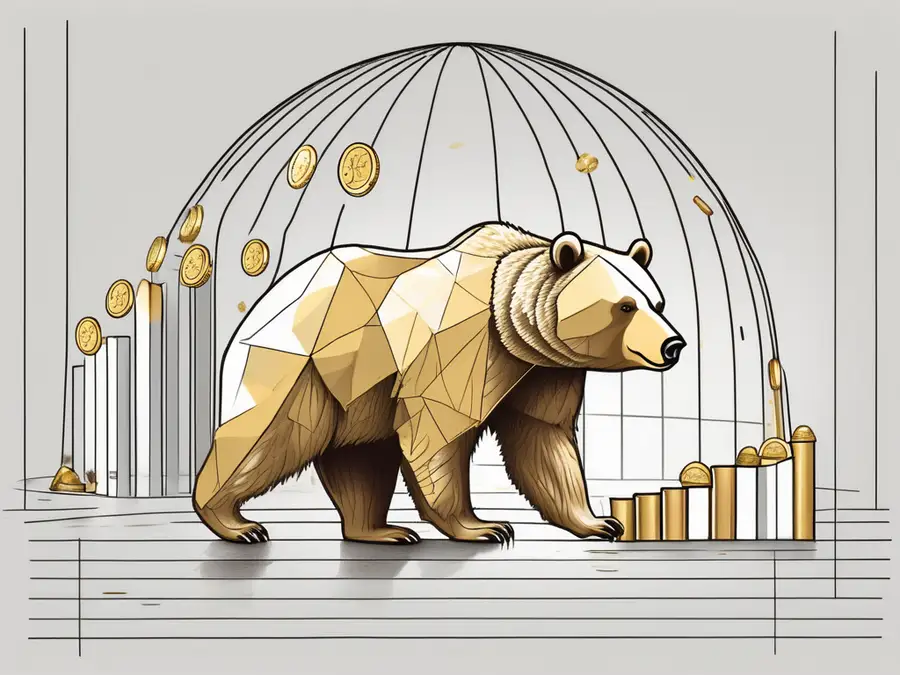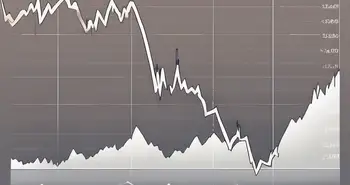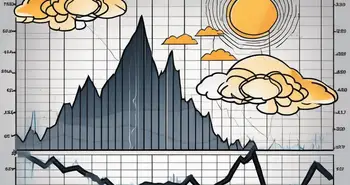The Importance of Safe-Haven Assets in Bear Markets

As an expert in finance and investments, I understand the importance of safe-haven assets in bear markets. In times of economic uncertainty, investors often seek refuge in these assets to protect their wealth and mitigate potential losses. In this article, we will explore the concept of bear markets, the role of safe-haven assets, and how to effectively diversify your portfolio to navigate turbulent times.
Understanding Bear Markets
Bear markets are a natural part of the economic cycle, characterized by a sustained decline in stock prices for an extended period. During these downturns, investor confidence wanes, leading to panic selling and a downward spiral in the market. Understanding the dynamics of bear markets is crucial for any investor looking to preserve their capital.
One key factor that contributes to the onset of a bear market is the presence of negative economic indicators, such as rising inflation, high interest rates, or geopolitical instability. These factors can erode investor confidence and trigger a sell-off in the market as investors anticipate further declines in asset prices.
Defining Bear Markets
In general, a bear market is considered to be a decline of 20% or more from a recent market peak. However, it's important to note that bear markets can vary in duration and severity. They can last for several months or even years, affecting different sectors and asset classes to varying degrees.
Historically, bear markets have been a regular occurrence in the financial markets, with the average duration of a bear market being around 1.4 years. However, the severity of bear markets can vary widely, with some being relatively mild corrections while others turn into prolonged recessions.
The Economic Impact of Bear Markets
Bear markets have far-reaching consequences beyond just the stock market. They can have a significant impact on consumer spending, employment rates, and overall economic growth. As investor sentiment declines, businesses often face challenges in accessing capital, leading to reduced investment and potential layoffs.
Moreover, bear markets can also impact government revenues as tax receipts decline due to lower corporate profits and capital gains. This can put pressure on government budgets and lead to austerity measures or increased borrowing to cover budget shortfalls, further impacting the overall economy.
The Concept of Safe-Haven Assets
Safe-haven assets are investments that tend to hold their value or even increase in price during times of market turmoil. These assets provide stability and act as a hedge against the volatility of bear markets. The primary goal of including safe-haven assets in your portfolio is to minimize losses and preserve wealth.
Investors often turn to safe-haven assets during periods of economic uncertainty or geopolitical instability. These assets are seen as a safe bet when traditional investments, such as stocks and real estate, may be experiencing heightened volatility. By allocating a portion of your portfolio to safe-haven assets, you can help protect your overall wealth and reduce the impact of market downturns.
What are Safe-Haven Assets?
Safe-haven assets can take various forms, such as gold, government bonds, and certain currencies. These assets typically have a low correlation with the stock market, meaning they tend to move independently from equities. This lack of correlation provides diversification benefits and reduces the overall risk of a portfolio.
Gold is one of the most well-known safe-haven assets, prized for its intrinsic value and historical role as a store of wealth. Government bonds, particularly those issued by stable governments, are also considered safe-haven assets due to their relatively low risk of default. In times of crisis, investors often flock to these assets, driving up their prices as demand increases.
The Role of Safe-Haven Assets in Financial Planning
Integrating safe-haven assets into your financial plan is crucial for long-term success. These assets act as a safeguard during times of market turbulence, balancing out the volatility of other investments in your portfolio. By diversifying your holdings and including safe-haven assets, you can better navigate the ups and downs of the market.
Furthermore, safe-haven assets can play a key role in preserving capital for future generations. By incorporating these assets into your investment strategy, you can help ensure that your wealth withstands economic downturns and remains intact over the long term. Whether you are a seasoned investor or just starting out, understanding the importance of safe-haven assets is essential for building a resilient and sustainable financial plan.
The Relationship Between Bear Markets and Safe-Haven Assets
Understanding the relationship between bear markets and safe-haven assets is key to making informed investment decisions during turbulent times.
How Safe-Haven Assets Perform During Bear Markets
Historically, safe-haven assets have performed well during bear markets. Gold, for instance, has been a popular safe-haven asset due to its intrinsic value and perceived stability. During times of heightened market volatility, investors often flock to gold as a store of value, thereby driving up its price.
The Risk and Reward of Safe-Haven Assets in Bear Markets
While safe-haven assets can provide stability and protection during bear markets, they are not without risks. Prices of these assets can be affected by various factors, such as changes in interest rates or geopolitical events. Additionally, the potential rewards of these assets may be limited compared to higher-risk investments.
Diversifying with Safe-Haven Assets
Diversification is a crucial strategy for weathering bear markets. By including safe-haven assets in your portfolio, you can reduce volatility and hedge against potential losses.
The Importance of Diversification in Bear Markets
During bear markets, various asset classes can be impacted differently. By diversifying your portfolio, you can spread your risk across different investments that are not highly correlated. This helps minimize the impact of any individual asset's decline on the overall value of your holdings.
Strategies for Incorporating Safe-Haven Assets into Your Portfolio
When incorporating safe-haven assets into your portfolio, it's essential to consider your investment goals, risk tolerance, and time horizon. Consult with a financial advisor to determine the appropriate allocation based on your specific circumstances. For example, you may allocate a certain percentage of your portfolio to gold or other safe-haven assets to provide a buffer against market volatility.
The Future of Safe-Haven Assets
Looking ahead, the future of safe-haven assets in bear markets remains uncertain. However, considering the cyclicality of markets, it is likely that these assets will continue to play a vital role in the investment landscape.
Predicting the Performance of Safe-Haven Assets
While we cannot predict the exact performance of safe-haven assets during future bear markets, historical trends suggest that they will continue to act as a haven for investors seeking stability. However, it's important to conduct thorough research and monitor the market dynamics before making any investment decisions.
The Long-Term Outlook for Safe-Haven Assets in Bear Markets
As an expert in the field, my advice is to view safe-haven assets as a long-term investment. While they can provide temporary shelter during bear markets, their true value lies in their ability to offer stability and portfolio diversification over time. Remember that investing is a marathon, not a sprint.
FAQs
What are safe-haven assets?
Safe-haven assets are investments that tend to hold their value or even increase in price during times of market turmoil. Examples include gold, government bonds, and certain currencies. These assets provide stability and act as a hedge against the volatility of bear markets.
Why are safe-haven assets important in bear markets?
In bear markets, investor sentiment declines, and stock prices plummet. Safe-haven assets serve as a safeguard, preserving wealth and minimizing potential losses. By diversifying your portfolio with safe-haven assets, you can navigate the ups and downs of the market more effectively.
How do safe-haven assets perform during bear markets?
Historically, safe-haven assets have performed well during bear markets. For example, gold tends to increase in price as investors seek a store of value. However, it's important to note that the performance of safe-haven assets can be influenced by various factors, such as interest rates and geopolitical events.
What is the future outlook for safe-haven assets?
While we cannot predict the exact future performance of safe-haven assets, it is likely that they will continue to play a vital role in bear markets. However, it's important to conduct thorough research and consider your individual investment goals and risk tolerance before incorporating these assets into your portfolio.
How can I effectively diversify with safe-haven assets?
Diversifying your portfolio with safe-haven assets involves allocating a portion of your investments to these assets. Consult with a financial advisor to determine the appropriate allocation based on your specific circumstances. By spreading your risk across different investments that are not highly correlated, you can reduce volatility and hedge against potential losses in bear markets.
What is the long-term outlook for safe-haven assets?
Safe-haven assets should be viewed as long-term investments. While they can provide temporary shelter during bear markets, their true value lies in their ability to offer stability and diversification over time. Remember to approach investing with a long-term mindset and continually evaluate your portfolio to ensure it aligns with your investment goals.
In conclusion, safe-haven assets play a crucial role in bear markets by providing stability, protecting wealth, and diversifying portfolios. By understanding the relationship between bear markets and safe-haven assets, investors can make informed decisions during volatile times. As an expert, my advice is to incorporate safe-haven assets into your portfolio, consult with a financial advisor, and approach investing with a long-term perspective. Safeguarding your wealth is paramount in today's unpredictable economic landscape.
As you consider the role of safe-haven assets in your investment strategy, especially during bear markets, explore the innovative solutions offered by Morpher. With its unique blockchain-based platform, Morpher empowers you to trade a variety of asset classes, including traditional safe-havens, without the burden of fees or liquidity constraints. Embrace the future of trading with fractional investing, short selling capabilities, and up to 10x leverage to enhance your portfolio's resilience. Experience the security and control of the Morpher Wallet and join a community of forward-thinking investors. Sign Up and Get Your Free Sign Up Bonus today to start your journey with Morpher, where investing meets innovation.

Disclaimer: All investments involve risk, and the past performance of a security, industry, sector, market, financial product, trading strategy, or individual’s trading does not guarantee future results or returns. Investors are fully responsible for any investment decisions they make. Such decisions should be based solely on an evaluation of their financial circumstances, investment objectives, risk tolerance, and liquidity needs. This post does not constitute investment advice.

Painless trading for everyone
Hundreds of markets all in one place - Apple, Bitcoin, Gold, Watches, NFTs, Sneakers and so much more.

Painless trading for everyone
Hundreds of markets all in one place - Apple, Bitcoin, Gold, Watches, NFTs, Sneakers and so much more.









